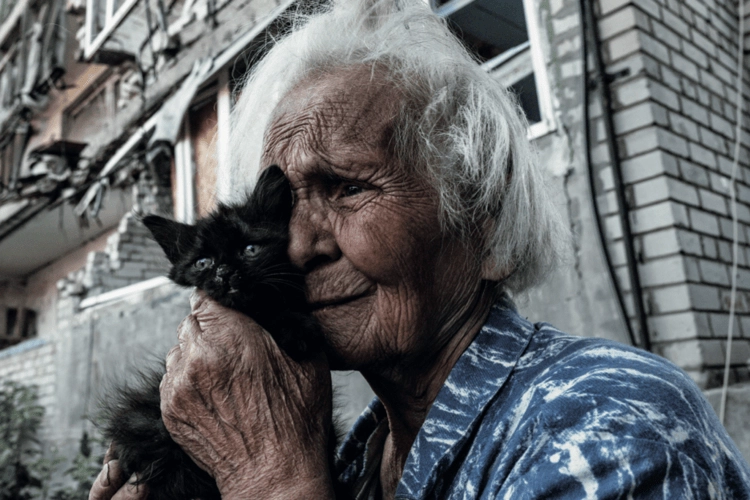
As devastation from the war continues, Sean Sutton captures the lives of Ukraine’s civilians living near the front line’s ‘Grey Zone’
By Sean Sutton and Bryony Cottam, photographs by Sean Sutton
More than two and half years have passed since Russia launched a full-scale invasion of Ukraine, and an estimated 3.3 million people remain displaced within their own country after fleeing their homes. Another six million are living abroad. As Russian forces push forward anew, however, many of the most vulnerable people in communities on the front lines of the war are left behind. Photojournalist Sean Sutton reports from the Donetsk region, where fighting is at its worst.

Anton sits on the bench outside his farmhouse where, just a few moments earlier, a shell had struck. Agitated, he explains how he’d spent that morning fixing up the barn after another shell hit nearby, blowing off part of the roof. Along the country back roads that lead to the house, deep tyre tracks and unnatural breaks in the tree line give away the recent presence of heavy artillery. Anton and his wife Natalia have taken to sleeping in the basement of the barn, where the air is thick with the stench of mould and damp. ‘How much longer can we stay here?’ they ask each other, ‘we’re going to have to leave. Or, maybe we can stay – maybe it’ll be okay.’ Anton worries over what would happen to his cow if they go.
When the evacuation order comes, most Ukrainians who can leave do. On 26 August this year, after the latest wave of attacks left 250,000 homes and businesses without electricity, local authorities announced the mandatory evacuation of children and accompanying adults from districts in northeastern and southeastern Ukraine. In the four days prior, police recorded an average of 2,700 attacks a day across front line communities in Donetsk Oblast.
For those who have family further west with room to spare, or who have the financial means to rent an apartment elsewhere, the decision is often an easy one.
Many others – among them the poorest, the elderly and the disabled – stay behind in what is grimly called the Grey Zone. In May this year, the International Organization for Migration (IOM) reported that nearly a million individuals were still living in the 33 municipalities closest to the front lines. But life at the forefront of the Russia–Ukraine war is increasingly dangerous. In July, as Russian armed forces shifted from northeastern Kharkiv to Donetsk, the number of civilian casualties reached the highest figures since October 2022.
Bombs drop daily on communities – post offices, coffee shops and convenience stores are frequent targets – and WHO-certified attacks on healthcare facilities have intensified significantly since December 2023. In an August press release, WHO representative Jarno Habicht revealed that Ukraine is experiencing more shelling of civilian infrastructure than ever before. ‘We are losing colleagues – healthcare workers, nurses, doctors, paramedics.’
Hana

84-year-old Hana stands with her kitten outside her damaged apartment in Lyman. Her home was hit three days prior, and recent clusterbomb strikes have left her in a state of constant fear and desperation. ‘Please take me to England,’ she pleads, overwhelmed by the relentless bombings and personal loss.
Anton & Natalia

Anton and Natalia live just four kilometres from the advancing front lines in Chasiv Yar. ‘Today we were told that because the fighting is getting closer, the authorities will stop delivering aid,’ says Anton as he feeds milk curds to the two-year-old calf of his prized cow, Romashka. ‘We are not suicidal, if we have to go then we will. My whole life has been rearing animals. We will sit here until it is impossible to stay.’
Nina & Alexander

Most of the people left in Siversk are older, like Nina and her husband Alexander. The couple are without gas and electricity and have little access to food. ‘We are living in constant fear, there is so much shelling.’
Antonia
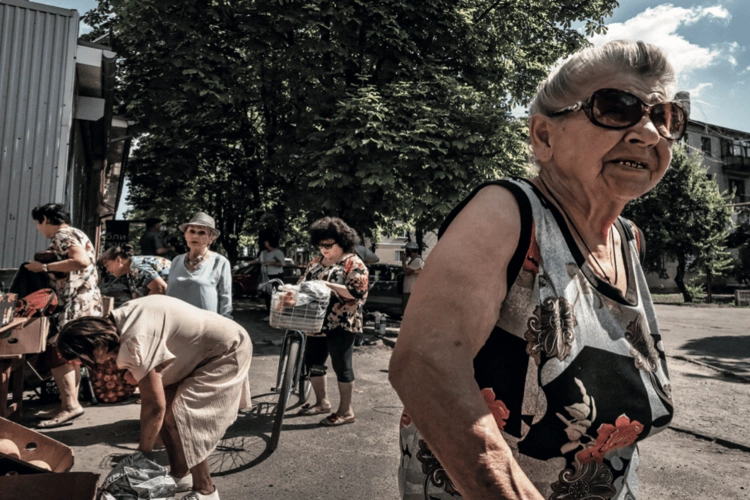
Antonia, 87, finds solace in visiting the market despite the danger. Reflecting on the enduring impact of war, she remains determined to maintain her dignity and beauty. ‘There was war when I was a little girl here; and now there is war when I am an old lady. Even though there is a war on and there is always danger, we want to be beautiful.’
Volodymyr
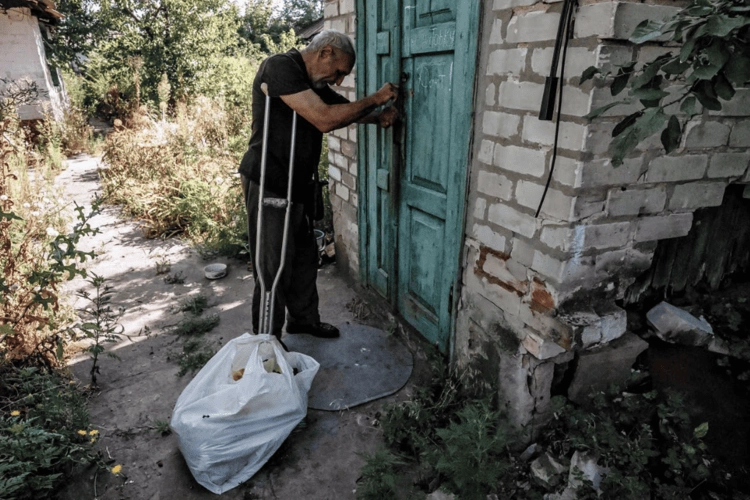
Volodymyr, a retired engineer, locks up his home, a small collection of his belongings in a plastic bag. His clothes – shirts, socks and trousers – are still hanging on the washing line when he leaves with volunteers from Angels of Salvation, who are assisting his evacuation.
In Toretsk, residents hide in their basements from the relentless bombardment of artillery fire, cluster munitions and drone attacks. Up until June this year, when Russian troops began to advance on population-dense centres in Donetsk, the coal-mining town had been largely spared by the war. Today, like most front line towns, it lies in ruin. Yet while some 70–80 per cent of Toretsk has been destroyed, an estimated 3,500 of its 35,000 former inhabitants are still living among the rubble, Donetsk Oblast governor Vadym Filashkin shared in a Telegram story on 24 July.
Irina

With three children, three grandchildren and a great- grandchild, 94-year-old Irina from Senenovka village remains steadfast: ‘The situation here is dire, but this is our home. How can we leave? My sister is hiding from the authorities because of her children – no children are allowed here as we are in the front line area. Rent costs 10,000 hryvnias, but we only receive 3,600 a month. Where could we possibly go?’
Anatoli

Anatoli lives in a basement in Lyman – in the Grey Zone – with his dogs and eight others after his apartment was destroyed in an air strike. He survives on his pension and humanitarian aid while his family is abroad.
Out on the streets, people are visibly distressed and dash between buildings, unwilling to stop and talk. In nearby Chasiv Yar, the remaining 500 residents have now been without water and electricity for more than a year. The UN estimates that, as of June, 14.6 million Ukrainians are in need of humanitarian assistance, with communities within 25 kilometres of the front lines facing the greatest challenges to accessing food, water, sanitation and shelter. Aid workers and uniformed services bring in much-needed supplies and provide medical and mental health support, but indiscriminate shelling makes aid distribution dangerous work. People are encouraged to evacuate, but many refuse.

Kostyantynivka railway station was destroyed in a missile strike in February 2024. Assaults have intensified in recent weeks as Russian forces continue to attack Ukrainian towns and villages in a determined attempt to take more territory in Donetsk Oblast.
Lavisha
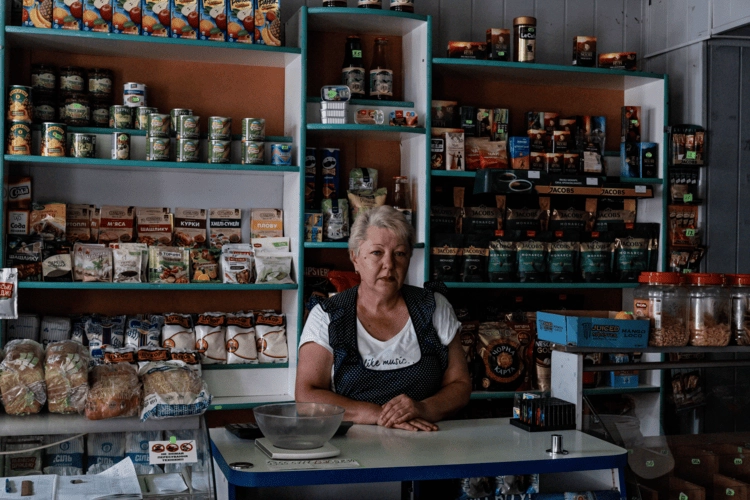
Lavisha owns a shop close to the front line, where her life has been disrupted by war for a decade now. ‘Our dreams stopped ten years ago. My children are overseas; I haven’t seen them in ten years. Now I have nothing left.’
As she stands behind her counter, Lavisha tearfully recounts her morning spent in the bunker, as bombs fell all around. She doesn’t know how much longer she can stay but, like many others, she’s uncertain of what awaits her if she leaves.
The war has tipped many people into destitution – since 2022, poverty has increased from 5.5 per cent to 24 per cent of Ukraine’s population – and for those living off a pension, roughly US$135 a month, there’s not nearly enough money to afford to live somewhere else. Across conflict-impacted regions of Ukraine, households continue to report limited access to bomb shelters, with many citing the lack of disability-friendly options. Some people refuse to be separated from elderly relatives and friends. Others know that if they leave, they may never get a chance to return to homes they’ve lived their whole lives in, and they have already lost too much.
Valentina

On the outskirts of Lyman in the Grey Zone, a partially demolished railway town just 15 kilometres from the front lines, a small group of women in swimsuits and sun hats sit on the sandy shores of a lake, their small dogs lolling in the shade. Shortly before they arrived, cluster bombs had torn through a block of flats just 200 metres away. An older woman in a blue suit, Valentine, and her friends are frustrated over missing their daily swim due to relentless bombing across the Grey Zone. ‘I’ve not been able to swim for three days now,’ she grumbles. As the bombs struck, she’d hidden in terror behind the trees that fringe the water.
One of the other women, Lena, from Kharkiv, rents an apartment in town to be near her husband on the front line. ‘I do this whenever he has any time off. But I can’t be in touch with him as there is no phone signal. So, I am always so stressed and nervous. I hope he comes tomorrow but I must also prepare for him not to come back to me.’
Volunteers in the Grey Zone

Volunteers work to clean up debris in Lyman after recent airstrikes. Despite the constant shelling, residents and other volunteers continue to pull together, bringing brooms, shovels and even diggers to clear away the rubble after the latest assault, in an attempt to restore some semblance of normalcy amid the ongoing conflict.
Rescue attempts in Lyman

Two firefighters at a time donned breathing apparatus and braved the smoke and the flames while the others fought the fire. Their equipment is basic and old and, after several hours of exhausting work, they still hadn’t found the couple who were trapped inside (see pictured below).
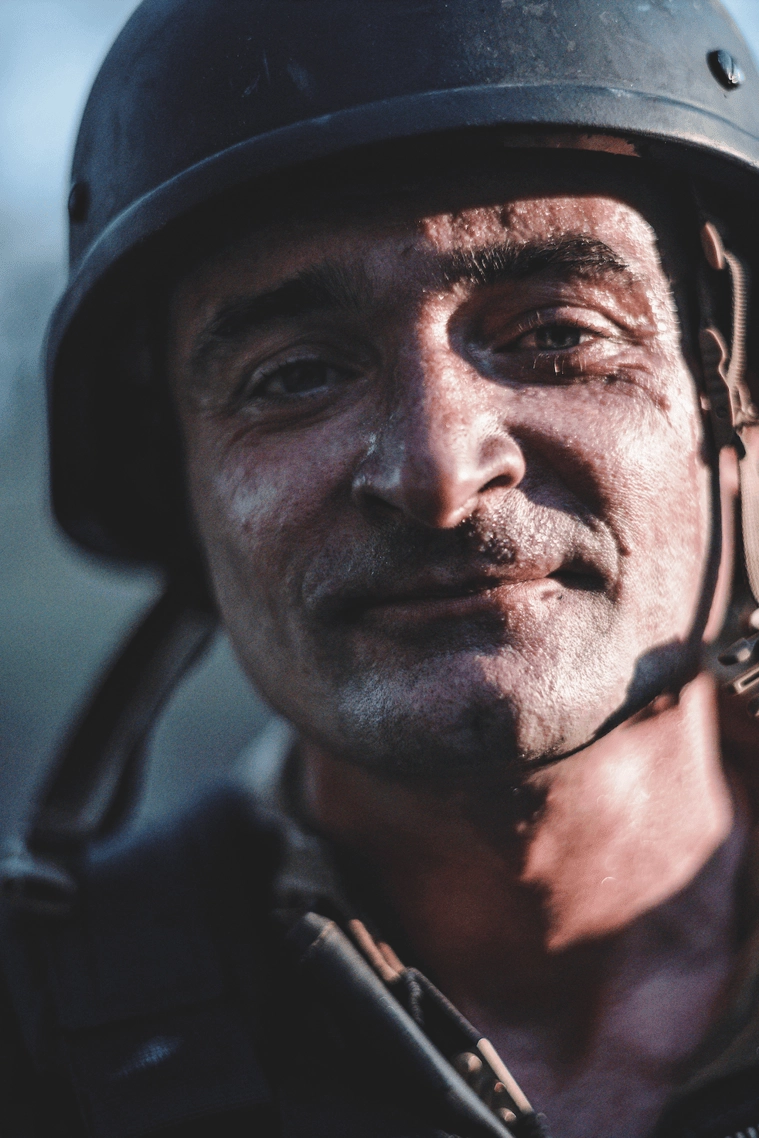
Among those who choose to remain, a smaller group do so from a sense of duty to their community, including firefighters, doctors and shopkeepers. They tackle blazes caused by airstrikes – pictured below, the fourth they had dealt with that day in Lyman in the Grey Zone.

Valentina and Volodymyr

Valentina and Volodymyr (above), finally rescued by the firefighters, leave their apartment in the Grey Zone after a devastating airstrike that left them trapped in their home. ‘We are so sad to lose our home. All of our life is here, all our family history. Now, everything we have, we carry in our bare hands. I can’t take it.‘
People carry on the best they can but, as Russian forces draw closer, the situation inevitably becomes hopeless. At the beginning of 2024, some 222,000 houses and 27,000 apartment buildings had been destroyed, and the numbers are increasing every day.
Even in areas where fighting has passed through, mines and environmental contamination have left the land inaccessible. As their homes are smashed by bombs, the last residents gather what few possessions they can into plastic bags, before teams of volunteers usher them into waiting vans.




